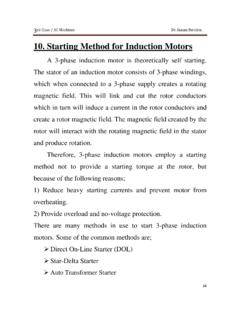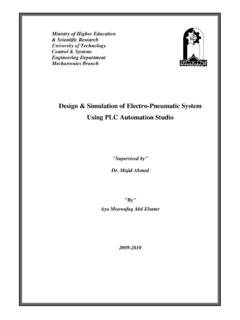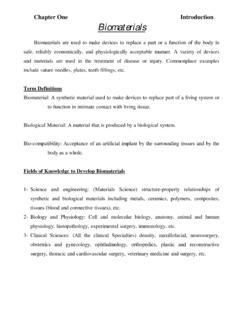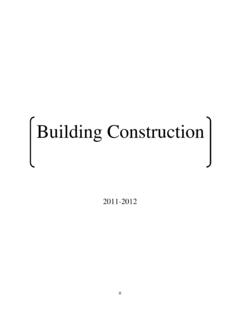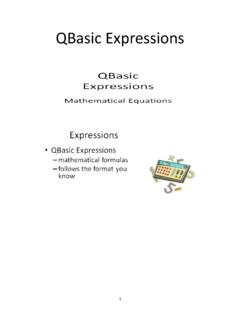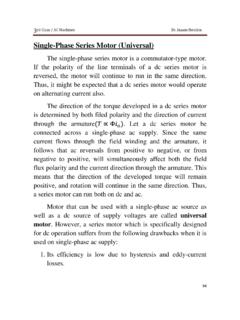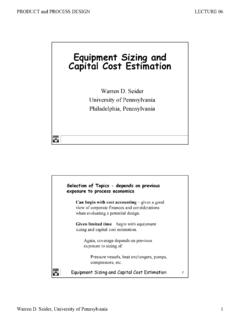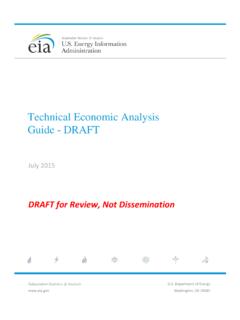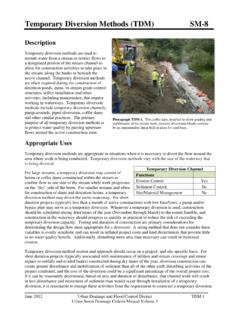Transcription of Mineral Processing Plant Design - University of Technology ...
1 1 Mineral Processing Plant Design General Procedure for Plant Design o Process Design o Flow sheet Design o Process Plant Simulation o General Arrangement Drawings Detailed Design Metallurgical involvement in the construction phase Commissioning (Cold commissioning, Hot commissioning) Practical commissioning tips Acceptance runs Conclusions Importance of Good Plant Design and in Time Commissioning A good Plant Design can minimize capital expenditure and maximize on long term profits. A good Plant Design together with careful planning and execution of the startup can greatly contribute towards: o easing commissioning problems, and o can ensure the Plant brought into production in time. To Design capacity and efficiency, And Within budget. Delays in commissioning can prove to become an extremely costly exercise in terms of profit loss due to loss of production 2 General Procedure for Plant Design Ore testing, Process definition, Production of basic flowsheet, Production of piping and instrument drawings, Production of general arrangement drawings and conceptual models, equipment selection and specification Costing and preparation of definitive budget, Production of final flowsheet, Construction, Commissioning Process Design Process Design criteria A statement of what the Plant will be required to do and the framework in which it will have to accomplish it.
2 It includes: The capacity of the Plant , Material to be treated, The sources of feed, The product, Time schedule for the commissioning of the various stages, General information regarding the externally imposed parameters of the Design . Normally prepared by the mining and financial consultants, Deals essentially with: What the Plant is to achieve, Basic directive to the Plant designer, Setting limits within which they should operate, And targets they must attain. 3 Flow sheet Design The flowsheet deals with the means by which the objectives are to be attained. Diagrammatic definition of how the requirements specified in the Design criteria are to be achieved. Flowsheet Design is a major and vital part of process Design , The correct choice of flowsheet is crucial to the technical and financial success.
3 The Design process Arranging in diagrammatic form the necessary equipment , installations and interconnections to achieve the goals specified in the Design criteria, Compiling with the treatment method indicated by the laboratory analysis, And any other source of information or requirements Various possible alternative technical treatment routes are roughly plotted and considered Quantified flow sheet For flowsheet to be used in subsequent costing, evaluation, and Design stages it must be quantified. Ie. It must include the following information: Flow streams throughput of the Plant , equipment to be installed, A table showing flow and equipment data, All primary data (data on which the flowsheet is based as per Design criteria and test results) Flow rates must be based on the full length of time as specified on the Design criteria, Initial flow rates must be correct when actual running times are available Secondary data calculations based on mass balance around the equipment must then be shown.
4 4 estimation of actual running time Initially flow data is based on 100% running time, Consideration must be given to the number of hours it will be manned and is planned to run, The proportion of lost time due to random unplanned breakdowns and stoppages must also be considered. The legal constraints of operation must also be considered, The following data must also be tabulated obtained from the lab results in order to complete the flow sheet: Size distribution, pH, temperatures and Reagent concentrations equipment sizing and selection o The Design procedures so far described have provided some of the essential data on which equipment sizing and selection can be based, o namely the flow data pertaining to each stream in the Plant . The next step is to determine with the help of this data, what capacity volume or energy input is required to bring about whatever change is required in each stream, whether of position, size distribution, chemical state, moisture content, etc.
5 There will be several combinations of available sizes and numbers of machine that will fulfil each requirement The decision as to which is the correct combination is essentially an economic one, that is, determination of the relative profitabilities of the various alternatives. 5 Crushing Plant Design and Layout Considerations Introduction In mining operations, the layout of crushing plants and ancillary equipment and structures is a crucial factor in meeting production requirements while keeping capital and operational costs to a minimum. The fundamental goal for the Design of a crushing Plant is an installation that meets the required production requirements, operates at competitive cost , complies with today s tough environmental regulations, and can be built at a reasonable price despite the rising costs of equipment , energy and construction labor.
6 The following industry trends must be taken into account: equipment suppliers are offering ever-larger primary crushers, with 1,800 mm (72 in) gyratories expected soon, as well as secondary and tertiary machines of up to 3,000 mm (120 in). Rising energy costs are causing owners to increase the integration of mine and mill Design , so that they can identify ways of reducing overall electrical power consumption. Electronic control of crusher discharge opening and feed rate. With adjustment of a crusher s discharge opening, as the production continues through an on-line coarse size analysis of the crushed product (digital image analyses). Dance, A. 2001) More attention is being paid to the impact on crushing circuit Design caused by variations in ore characteristics, size distribution, moisture content, ore grade and climatic conditions.
7 Operators have always dreamed of reducing the need for crushing equipment ; when SAG mills were first introduced, it was hoped that they would eliminate secondary 6 and tertiary circuits. As it turned out, designers are now adding secondary or pebble crushers to SAG circuits, on both greenfield and retrofit projects, to increase feed rate to the SAG mill. In other words, crushing plants, from primary to quaternary circuits, are here to stay. There are three main steps in designing a good crushing Plant : process Design , equipment selection, and layout. The first two are dictated by production requirements and Design parameters, but the layout can reflect the input, preferences and operational experience of a number of parties. These can include the owner s engineering staff, safety personnel, operations and maintenance personnel, equipment manufacturers, and the engineering consultant.
8 Ideally, the consultant combines his knowledge and experience with an understanding of all parties needs, to provide a balanced, workable, safe and economic Plant Design . Design parameters The principal Design parameters that drive crushing Plant selection and configuration include: Production requirements capital cost Ore characteristics Safety and environment Project location Life of mine/expansion plans Operational considerations Maintenance requirements Climatic conditions Each of these is addressed in the sections that follow. 7 Production Requirements The process Design criteria define the project s production requirements, and typically include those shown in Table 1. Table 1 Production requirements Process Description General Ore Characteristics Operating Schedule General Primary crushing Fines crushing Storage & reclaim Maximum rock size in the feed Ore types, compressive strengths and abrasion indices Ore specific gravity Ore bulk density Ore moisture, wet season Ore moisture, dry season Angle of repose Angle of withdrawal Angle of surcharge Days per year Hours per day Nominal annual throughput Mining shifts per day Crushing Plant shifts per day System availability and utilization The flowsheet specifies the nominal Design , peak production flow rate, and equipment sizing to handle those capacities.
9 Manufacturers provide ratings for their equipment , preferably based on testwork and/or experience, so a project flowsheet specifies tonnage requirements and the equipment is selected to meet or exceed the capacities. Design criteria can be calculated from a simple spreadsheet as shown in Table 2. Mine haul-truck capacity is an important factor at primary crusher installations, because it is cost -effective to integrate truck cycle time at the crusher station with mine/shovel operations. If a primary crusher dump pocket is undersized and unable to handle the mine s trucks, then operators must slowly meter the ore into the receiving hopper. 8 9 capital cost Direct Costs. The largest primary gyratory crushers cost US $2 million or more, while overall crushing Plant costs can be as high as $18 million.
10 It s necessary therefore to estimate crusher installation costs based on equipment costs plus the following direct costs, including construction contractor indirects: Earthworks Mechanical Concrete Electrical Structural steel Instrumentation. Architectural Indirect Costs. Indirect costs can fall within a range of 40 to 60% of the direct costs, and include: Construction indirects Startup and commissioning Construction equipment Freight Spare parts/first fill Taxes/duties Engineering, procurement and Owner s costs (relocation, hiring and training construction management (EPCM) personnel, permits, licensing fees, etc). In addition to the above, a contingency to cover unforeseen costs will be in the range of 10 to 20% of the sum of the direct and indirect costs.
